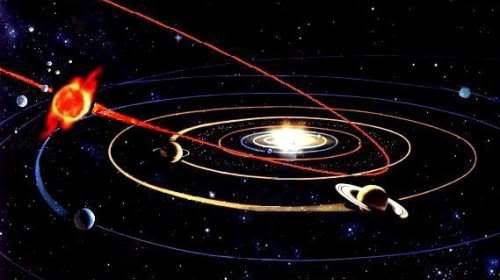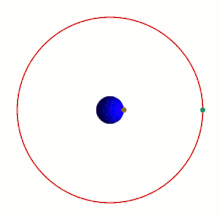Skip to comments.
The GEO Graveyard May Not Be Permanent
SPX via Space Daily ^
| 11/09/2010
| SPX via Space Daily
Posted on 11/08/2010 10:35:52 PM PST by ErnstStavroBlofeld
Since the 1970s, a number of geostationary satellites have been placed in the so called "graveyard orbit," an orbit just above the GEO altitude, roughly 100 to 300 km. The sole purpose of this "burial" location is to remove expired satellites from the highly-congested GEO ring about the equator. Although most GEO satellite operators have not taken advantage of removing their old spacecraft, there are over 100 already there. This number will continue to grow, because some 20 GEO birds expire each year, and some of these will be sent to the graveyard. Thus, the total number of graveyard residents will increase indefinitely.
Operators that use the "end-of-life" maneuver to rid GEO of future debris feel relieved that they do not have to be concerned about their old satellites interfering with operating birds. After all, as the number of dead satellites in GEO increases, the probability of collisions increases.
Once collisions start occurring the frequency of such events will surely increase dramatically. So, the graveyard orbit seems like a good long-term solution to eventual uncontrolled debris generation in GEO.
(Excerpt) Read more at spacedaily.com ...
TOPICS: Foreign Affairs; News/Current Events
KEYWORDS: earthorbit; orbit; space; spacedebris; spacejunk; spacescience
To: ErnstStavroBlofeld
Estimates indicate that the day will increase just a few minutes over the next 20 million years. Given the typical satellite life span of less than 20 years, there appears to be no immediate concern regarding maintenance of station or increases in collision threats at GEO. Which means the entire point of this article erased itself.
Because either an organization that produces professional courses entitled "Advanced Geostationary Orbit Mechanics and Operations" for launch center personnel is actually trying to shop a 20 million year long irrelevency, or... something other than the moon is soon going to effect the change in the length of an Earth day, and this needs to be understood by the folks who calculate satellite orbits.
Hmmm... what could possibly have such a powerful and imminent effect on Earth's rotation?

2
posted on
11/08/2010 10:51:22 PM PST
by
Talisker
(When you find a turtle on top of a fence post, you can be damn sure it didn't get there on its own.)
To: ErnstStavroBlofeld
“The sole purpose of this “burial” location is to remove expired satellites from the highly-congested GEO ring about the equator.”
Love it when we have a technical article showing an image ninety degrees out of phase with the description.
3
posted on
11/08/2010 10:57:26 PM PST
by
Bobibutu
To: Bobibutu
Love it when we have a technical article showing an image ninety degrees out of phase with the description. The article is garbage. The picture itself is well known, and it shows known debris around the planet. Those are not limited to the geostationary orbit, and in fact - given the scale - only the LEO debris are shown. The geostationary orbit, being 22,236 miles above ground, would look like this:

There is still a valid concern that satellites at the graveyard orbit will be bombarded by space dust and larger meteorites and eventually that will result in either slowing down of the whole satellite or in chipping small pieces off; then those pieces can get into lower orbits. But the article talks about ridiculous things; did *any* editor at Space Daily even read this stuff? Do they allow anyone off the street to post anything they want?
4
posted on
11/08/2010 11:20:48 PM PST
by
Greysard
To: ErnstStavroBlofeld
5
posted on
11/09/2010 12:26:31 AM PST
by
JSteff
((((It was ALL about SCOTUS. Most forget about that and HAVE DOOMED us for a generation or more.))))
To: ErnstStavroBlofeld
6
posted on
11/09/2010 12:29:42 AM PST
by
JSteff
((((It was ALL about SCOTUS. Most forget about that and HAVE DOOMED us for a generation or more.))))
To: Greysard
It won’t be too long from now that we’ll be able to rendezvous with those sattelites, attach a small ion thruster, and send them on their way into deep sapace.
7
posted on
11/09/2010 4:01:43 AM PST
by
saganite
(What happens to taglines? Is there a termination date?)
To: ErnstStavroBlofeld
Why aren’t they just de-orbited? It would take a lot less fuel to put them over the ocean to burn up.
8
posted on
11/09/2010 4:21:06 AM PST
by
TangoLimaSierra
(To the left the truth looks Right-Wing.)
To: ErnstStavroBlofeld
I’ve long been a proponent of an idea to clear some of the detritus from the more desirable orbital paths, using what can be called “a big ball of goo”.
It is a fairly low tech satellite that once in orbit, extends a number of telescoping tubes in many directions. Attached to the ends of these tubes is a large tent. The result is a very large “tent-ball”, with the very tips of the tubes sticking out of it.
The satellite then sprays an inert gas into the tent, creating a mini atmosphere in the tent, that warms in sunlight. When the gas is warm, then the satellite fills the tent with high expansion polymer foam, that hardens into something like a tough and sticky Styrofoam.
Spraying gas through the tubes, they can be used as thrusters to change the path of the ball of goo, to collide with space junk, which will embed itself in the goo.
Eventually, with several tons stuck in it, it will use the last of its power to burn up in the atmosphere.
To: yefragetuwrabrumuy
That would be like trying to mop your floors by stapling a q-tip to your shoe.
‘Several tons’? Eventually? Try thousands of years.
Also if it actually intersect a serious chunk of junk it could easily be blown to tiny chunks, goo or no goo. Orbital velocities are massive.
10
posted on
11/09/2010 6:34:14 AM PST
by
TalonDJ
To: TalonDJ
Well, yes and no. While a high speed object can travel at about 5 miles a second, or 18,000 mph, most are only a fraction of that.
Years ago, at the University of Arizona, a professor invented a satellite to help police up orbital debris.
http://articles.latimes.com/1995-01-01/local/me-15238_1_space-junk
The secret for the “big ball of goo” is that tough, high tech polymer foams can act much like a catcher’s mitt, and while a small, very high speed object can easily penetrate its outer layers, it can only do so at great cost to its momentum.
To: yefragetuwrabrumuy
That could be useful if you are trying to catch small targets in known orbits.
Anything in low earth orbit is going to be doing 5miles a second. If you are interseting that your closure rate could be as much as double that.
12
posted on
11/09/2010 8:55:31 AM PST
by
TalonDJ
To: TangoLimaSierra
Why aren’t they just de-orbited? It would take a lot less fuel to put them over the ocean to burn up. It would take a lot more fuel to slow the satellite enough to deorbit, and in doing so it will also have to go through lower orbits on its way down. Orbits that things like GPS satellites and space stations occupy. So you not only need fuel to slow the satellite sufficiently to get it entirely out of orbit, you need enough fuel to maneouver it on the way down to avoid other collisions.
13
posted on
11/09/2010 10:23:06 AM PST
by
Yo-Yo
(Is the /sarc tag really necessary?)
To: KevinDavis
Thanks ErnstStavroBlofeld. Found this while looking for a recent topic on elliptical orbits that can do much of what is now done with GEOs, but from lower altitude.
14
posted on
11/27/2010 1:35:57 PM PST
by
SunkenCiv
(The 2nd Amendment follows right behind the 1st because some people are hard of hearing.)
Disclaimer:
Opinions posted on Free Republic are those of the individual
posters and do not necessarily represent the opinion of Free Republic or its
management. All materials posted herein are protected by copyright law and the
exemption for fair use of copyrighted works.
FreeRepublic.com is powered by software copyright 2000-2008 John Robinson

